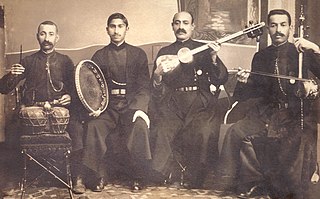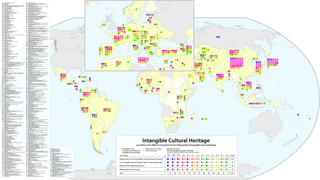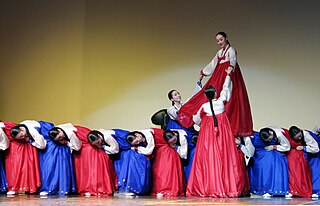
The polonaise is a dance originating in Poland, and one of the five Polish national dances in 3
4 time. Its name is French for "Polish" adjective feminine/"Polish woman"/"girl". The original Polish-language name of the dance is chodzony, denoting a walking dance. It is one of the finest dances representing Poland's cultural dance tradition. The polonaise dance influenced European ballrooms, folk music and European classical music.

Kaustinen is a municipality of Finland. It is part of the Central Ostrobothnia region. The municipality has a population about 4300 and covers an area of 361.12 square kilometres (139.43 sq mi) of which 7.09 km2 (2.74 sq mi) is water. The population density is 11.66 inhabitants per square kilometre (30.2/sq mi).
Táncház is a "casual" Hungarian folk dance event. It is an aspect of the Hungarian roots revival of traditional culture which began in the early 1970s, and remains an active part of the national culture across the country, especially in cities like Budapest. Táncház draws on traditions from across the regions of the Kingdom of Hungary, especially music and dance. The term is derived from a Transylvanian tradition of holding dances at individuals' homes.
The Proclamation of Masterpieces of the Oral and Intangible Heritage of Humanity was made by the Director-General of UNESCO starting in 2001 to raise awareness of intangible cultural heritage and encourage local communities to protect them and the local people who sustain these forms of cultural expressions. Several manifestations of intangible heritage around the world were awarded the title of Masterpieces to recognize the value of the non-material component of culture, as well as entail the commitment of states to promote and safeguard the Masterpieces. Further proclamations occurred biennially. In 2008, the 90 previously proclaimed Masterpieces were incorporated into the new Representative List of the Intangible Cultural Heritage of Humanity as its first entries.
A Living Human Treasure is, according to UNESCO, a person who possesses to a high degree the knowledge and skills required for performing or re-creating specific elements of the intangible cultural heritage. This title or a form of it is awarded by the nation's government to a person who is regarded as a national treasure while still alive. The title is also known as Living National Treasure.

Chhau, also spelled Chhou, is a semi classical Indian dance with martial and folk traditions. It is found in three styles named after the location where they are performed, i.e. the Purulia Chhau of West Bengal, the Seraikella Chhau of Jharkhand and the Mayurbhanj Chhau of Odisha.
An intangible cultural heritage (ICH) is a practice, representation, expression, knowledge, or skill considered by UNESCO to be part of a place's cultural heritage. Buildings, historic places, monuments, and artifacts are cultural property. Intangible heritage consists of nonphysical intellectual wealth, such as folklore, customs, beliefs, traditions, knowledge, and language. Intangible cultural heritage is considered by member states of UNESCO in relation to the tangible World Heritage focusing on intangible aspects of culture. In 2001, UNESCO made a survey among states and NGOs to try to agree on a definition, and the Convention for the Safeguarding of the Intangible Cultural Heritage was drafted in 2003 for its protection and promotion.

Mugham or Mughamat is one of the many classical compositions from Azerbaijan, contrasting with tasnif and ashik.
The Center for Folklife & Cultural Heritage (CFCH) is one of three cultural centers within the Smithsonian Institution in the United States. Its motto is "culture of, by, and for the people", and it aims to encourage understanding and cultural sustainability through research, education, and community engagement. The CFCH contains (numerically) the largest collection in the Smithsonian, but is not fully open to the public. Its budget comes primarily from grants, trust monies, federal government appropriations, and gifts, with a small percentage coming from the main Smithsonian budget.

UNESCO established its Lists of Intangible Cultural Heritage with the aim of ensuring better protection of important intangible cultural heritages worldwide and the awareness of their significance. This list is published by the Intergovernmental Committee for the Safeguarding of Intangible Cultural Heritage, the members of which are elected by State Parties meeting in a General Assembly. Through a compendium of the different oral and intangible treasures of humankind worldwide, the programme aims to draw attention to the importance of safeguarding intangible heritage, which UNESCO has identified as an essential component and as a repository of cultural diversity and of creative expression.

Ojkanje is a tradition of polyphonic folk singing in Croatia characteristic for the regions of the Dalmatian hinterland, Velebit, Lika, Kordun, and Karlovac. As described in The Harvard Dictionary of Music: "The ojkanje is a particular style of singing melisma with a sharp and prolonged shaking of the voice on the syllables oj or hoj."

Gangneung Danoje (Korean: 강릉단오제), called by locals Danogut (단오굿), is a yearly celebration of the Korean holiday Dano, in Gangneung, Gangwon Province, South Korea. The festival is traditionally held for 47 days: in the lunisolar Korean calendar, between the 20th day of the 3rd month to the 7th day of the 5th month. Its purpose is to appease the local gods, and in turn to receive their blessings.

Ramman is a religious festival and ritual theatre of the Garhwal region in India. It is a festival of the Garhwali People celebrated in many villages of the region. Although there are many Rammans, such as the Jak Ramman, one of the most popular is the masked Ramman of the Saloor Dungra village of the Painkhanda Valley in the Chamoli district in Uttarakhand, India.

Czech folklore is the folk tradition which has developed among the Czech people over a number of centuries. Czech folklore was influenced by a mix of Christian and pagan customs. Nowadays it is preserved and kept alive by various folklore ensembles uniting members of all ages, from children to seniors, showing their talent during competitions, folklore festivals or other performances.

The Festivity of La Mare de Déu de la Salut is a festival celebrated in Algemesí (Valencia), Spain, from August 29 to September 8. The festival is in honour of the patron saint of Algemesí, La Mare de Déu de la Salut, and has been dated back to 1247. The holiday was awarded the UNESCO "Masterpieces of the Oral and Intangible Heritage of Humanity" designation on November 28, 2011.

The heritage preservation system of South Korea is a multi-level program aiming to preserve and cultivate Korean cultural heritage. The program is administered by the Cultural Heritage Administration (CHA), and the legal framework is provided by the Cultural Heritage Protection Act of 1962, last updated in 2012. The program started in 1962 and has gradually been extended and upgraded since then.
Intangible cultural heritage (ICH) includes traditions and living expressions that are passed down from generation to generation within a particular community.

Lahıc copper craft is a traditional folk art of Lahıc, Ismailli in Azerbaijan. It includes the production of copper crockery and other products. It was added to UNESCO's Representative List of the Intangible Cultural Heritage of Humanity in 2015.
Folk and traditional arts are rooted in and reflective of the cultural life of a community. They encompass the body of expressive culture associated with the fields of folklore and cultural heritage. Tangible folk art includes objects which historically are crafted and used within a traditional community. Intangible folk arts include such forms as music, dance and narrative structures. Each of these arts, both tangible and intangible, was originally developed to address a real need. Once this practical purpose has been lost or forgotten, there is no reason for further transmission unless the object or action has been imbued with meaning beyond its initial practicality. These vital and constantly reinvigorated artistic traditions are shaped by values and standards of excellence that are passed from generation to generation, most often within family and community, through demonstration, conversation, and practice.

Sebiba is the term used in Algeria to designate a festival and the Tuareg people's dance performed on this occasion and accompanied by female drummers in the Sahara oasis of Djanet in the Tassili n'Ajjer region in southern Algeria. The dance originated among the descendants of black African slaves and is part of the celebrations for the Islamic Ashura Festival. The dance was recognized by UNESCO in 2014 for its significance to humanity's intangible cultural heritage.














